Although cryptozoology is not considered a real science, it is based on the sciences zoology and paleontology,
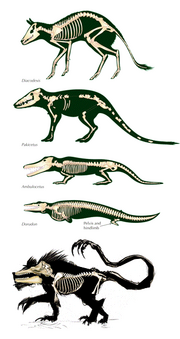
Possible evolution of the Talk Ahizotoul
which solely revolve around the scientific fact of evolution. Many Cryptids probably don't exist, but there is a high possibility that others do. In fact, National Geographic proved that hogzilla and the Congo Elephants, two Cryptids thought to be hoaxes or not exist, did. If more Cryptids do exist, there are scientific evolutionary roots on to how these creatures possibly evolved.
Evolution's Importance to Cryptozoology
Cryptozoology has been traditionally researched with a bias towards the scientific fact of evolution. Bigfoot theories are abound with speculation as to whether they represent the "missing link". Bernard Heuvelmans, the late Belgian zoologist known as the “father of cryptozoology”, defined cryptozoology as...
"The scientific study of hidden animals, i.e., of still unknown animal forms about which only testimonial and circumstantial evidence is available, or material evidence considered insufficient by some!"
Cryptozoologist Loren Coleman described his founder and friend, Bernard Heuvelmans's, interest in evolution as "...Heuvelmans found he had a love of natural history from an early age, keeping all kinds of animals, especially monkeys. At school, he shocked his Jesuit teachers by his unholy interest in evolution...[His] impact was enormous. As one critic remarked at the time, 'Because his research is based on rigorous dedication to scientific method and scholarship and his solid background in zoology, Heuvelmans's findings are respected throughout the scientific community.' Soon Heuvelmans was engaged in massive correspondence as his library and other researches continued...Heuvelmans corresponded with many cryptozoologists worldwide, as he did with me, over the decades. By the 1960s, most in the field had elevated Blancou's phrase in honor of Heuvelmans, and Heuvelmans was being called the 'Father of Cryptozoology.' Writing in Cryptozoology in 1984, Heuvelmans said, 'I tried to write about it according to the rules of scientific documentation.'"
Loren Coleman, one of the most famous cryptozoologists of all time, had written an obituary for an evolutionary anthropologist, Grover Krantz, with a "concentration in human evolution." Coleman praised Krantz, stating, "...[he] was never afraid to take the unpopular academic position that the primates called Sasquatch actually exist..."
Bigfoot Evolution
There have been numerous reported sightings, and sasquatch researchers have found hair, footprints and body prints, but there is still no conclusive evidence that such a creature exists. When
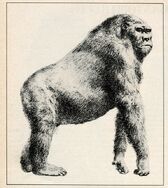
considering the sasquatch scientifically, the first question is whether or not such a creature could exist, given what we know about zoology. This is an easy one, because fossil evidence shows that such a creature did exist, 1 to 9 million years ago. This animal, which scientists call gigantopithecus, was native to what is now central and southeast Asia. On the evolutionary tree, gigantopithecus is most closely related to the orangutan, the only modern Asian ape (gorillas and chimpanzees live in Africa).
The most likely explanation of both yeti and sasquatch (if they do exist) is that they are direct descendants of gigantopithecus. There is no evidence of primates evolving in the Americas, so presumably, descendants of gigantopithecus got here the way many humans did: by crossing an ice bridge between northern Asia and northern North America. We don't know much about gigantopithecus, except that it was larger than a gorilla and had teeth similar to a human's. It is compelling that the closest living relative of gigantopithecus, the orangutan, shares some of the characteristics that eyewitnesses attribute to sasquatch. Orangutans are covered in long, reddish-brown
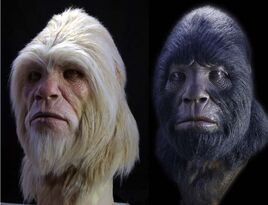
hair, are highly intelligent and exhibit a great deal of curiosity about human behavior. They are not particularly vocal, but will on occasion make loud, howling calls to alert other orangutans of their presence.
Orangutans are remarkably different from other primates in how they live. While most apes and monkeys form tight-knit communities, orangutans are solitary creatures. After childhood, they gather with other orangutans only to reproduce. Orangutans are so widely dispersed in an area that they only rarely run across one another.
This sort of behavior might account for the rarity of sasquatch sightings, as well as the lack of skeletal remains. It makes sense that an intelligent animal that prefers to be alone would retreat into the deep woods (or up into the mountains) as human civilization encroached on its territory. And if
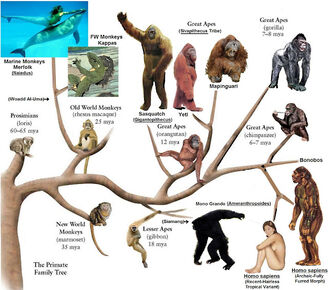
Primate family tree created by Dale Drinnon. Image from frontiersofzoology.blogspot.com
it were smart enough, it could conceivably hide from humans for hundreds and hundreds of years. If the population were widely dispersed, as with orangutans, and the animal had a fairly long life span, as do orangutans and other apes, skeletal remains would show up only once in a while. Most bones decay in a relatively short period of time (as few as 5 to 10 years), so it is possible that scientists wouldn't come across them at all. Believers in sasquatch suggest that it is not only possible, but quite likely that the bones would go undiscovered, since there has never been a full-blown, scientific search for them. The gigantopithecus-descendant theory is the most likely explanation of where sasquatches might come from.
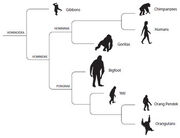
Reptilian Humanoids and Lizard Men
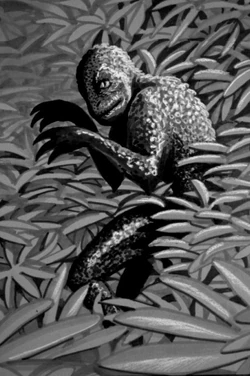
Many theories have been presented in relation to the identity of the Lizard men, theories such as living dinosaurs, and even off shoots of evolution in which the reptilian hierarchy continued to evolve along the same path as early [[::Category:Primates|primates]]. At one point in time reptiles ruled the earth, it is not out of the realm of possibility that the most dominate species on the planet could continue to evolve in small numbers unseen by mankind. Although no reptilian species known to man have shown signs of such advanced evolution, the reptile is the oldest and most successful species on the planet and could hold secrets that have yet to come to light.
In 1982, Dale Russell, curator of vertebrate fossils at the National Museum of Canada in Ottawa, conjectured a possible evolutionary path that might have been taken by the dinosaur Troodon had it not perished in the K/T extinction event 65 million years ago, suggesting that it could have evolved into intelligent beings similar in body plan to humans. Over geologic time, Russell noted that there had been a steady increase in the encephalization quotient or EQ (the relative brain weight when compared to other species with the same body weight) among the dinosaurs. Russell had discovered the first Troodontid skull, and noted that, while its EQ was low compared to humans, it was six times higher than that of other dinosaurs. If the trend in Troodon evolution had continued to the present, its brain case could by now measure 1,100 cm3; comparable to that of a human. Troodontids had semi-manipulative fingers, able to grasp and hold objects to a certain degree, and binocular vision. Russell proposed that this "Dinosauroid", like most dinosaurs of the troodontid family, would have had large eyes and three fingers on each hand, one of which would have been partially opposed. As with most modern reptiles (and birds), he conceived of its genitalia as internal. Russell speculated that it would have required a navel, as a placenta aids the development of a large brain case. However, it would not have possessed mammary glands, and would have fed its young, as birds do, on regurgitated food. He speculated that its language would have sounded somewhat like bird song.
